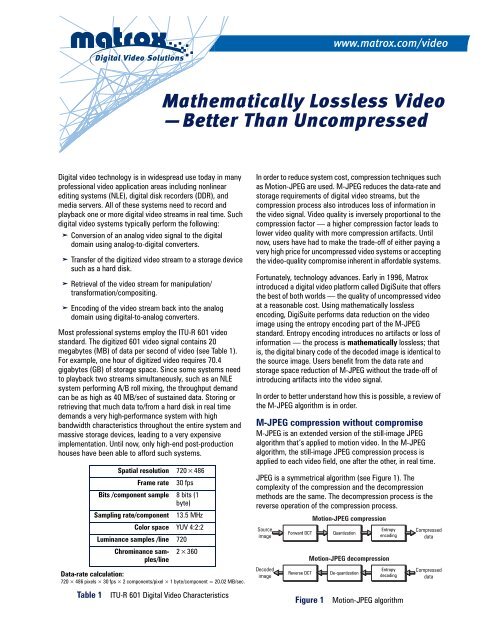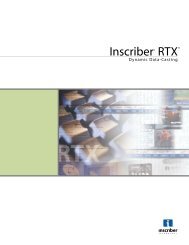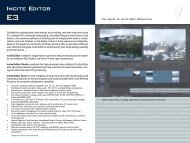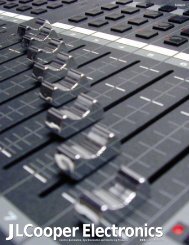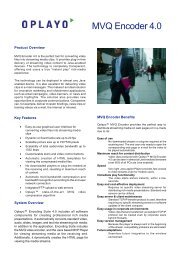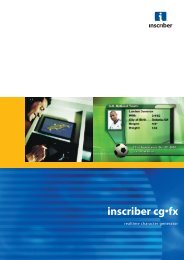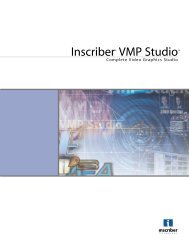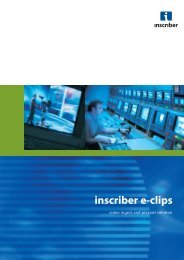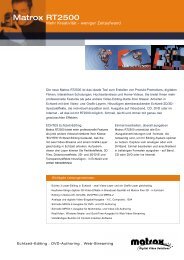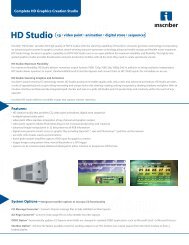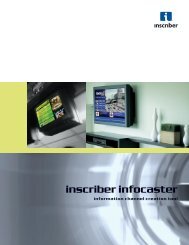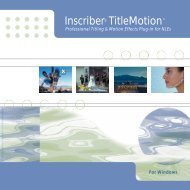Mathematically Lossless Video â Better Than Uncompressed
Mathematically Lossless Video â Better Than Uncompressed
Mathematically Lossless Video â Better Than Uncompressed
You also want an ePaper? Increase the reach of your titles
YUMPU automatically turns print PDFs into web optimized ePapers that Google loves.
Digital <strong>Video</strong> Solutions<br />
Digital video technology is in widespread use today in many<br />
professional video application areas including nonlinear<br />
editing systems (NLE), digital disk recorders (DDR), and<br />
media servers. All of these systems need to record and<br />
playback one or more digital video streams in real time. Such<br />
digital video systems typically perform the following:<br />
➤ Conversion of an analog video signal to the digital<br />
domain using analog-to-digital converters.<br />
➤ Transfer of the digitized video stream to a storage device<br />
such as a hard disk.<br />
➤ Retrieval of the video stream for manipulation/<br />
transformation/compositing.<br />
➤ Encoding of the video stream back into the analog<br />
domain using digital-to-analog converters.<br />
Most professional systems employ the ITU-R 601 video<br />
standard. The digitized 601 video signal contains 20<br />
megabytes (MB) of data per second of video (see Table 1).<br />
For example, one hour of digitized video requires 70.4<br />
gigabytes (GB) of storage space. Since some systems need<br />
to playback two streams simultaneously, such as an NLE<br />
system performing A/B roll mixing, the throughput demand<br />
can be as high as 40 MB/sec of sustained data. Storing or<br />
retrieving that much data to/from a hard disk in real time<br />
demands a very high-performance system with high<br />
bandwidth characteristics throughout the entire system and<br />
massive storage devices, leading to a very expensive<br />
implementation. Until now, only high-end post-production<br />
houses have been able to afford such systems.<br />
Spatial resolution 720×486<br />
Frame rate 30 fps<br />
Bits /component sample 8 bits (1<br />
byte)<br />
Sampling rate/component 13.5 MHz<br />
Color space YUV 4:2:2<br />
Luminance samples /line 720<br />
Chrominance samples/line<br />
2×360<br />
Data-rate calculation:<br />
720 × 486 pixels × 30 fps × 2 components/pixel × 1 byte/component = 20.02 MB/sec.<br />
Table 1 ITU-R 601 Digital <strong>Video</strong> Characteristics<br />
www.matrox.com/video<br />
<strong>Mathematically</strong> <strong>Lossless</strong> <strong>Video</strong><br />
— <strong>Better</strong> <strong>Than</strong> <strong>Uncompressed</strong><br />
In order to reduce system cost, compression techniques such<br />
as Motion-JPEG are used. M-JPEG reduces the data-rate and<br />
storage requirements of digital video streams, but the<br />
compression process also introduces loss of information in<br />
the video signal. <strong>Video</strong> quality is inversely proportional to the<br />
compression factor — a higher compression factor leads to<br />
lower video quality with more compression artifacts. Until<br />
now, users have had to make the trade-off of either paying a<br />
very high price for uncompressed video systems or accepting<br />
the video-quality compromise inherent in affordable systems.<br />
Fortunately, technology advances. Early in 1996, Matrox<br />
introduced a digital video platform called DigiSuite that offers<br />
the best of both worlds — the quality of uncompressed video<br />
at a reasonable cost. Using mathematically lossless<br />
encoding, DigiSuite performs data reduction on the video<br />
image using the entropy encoding part of the M-JPEG<br />
standard. Entropy encoding introduces no artifacts or loss of<br />
information — the process is mathematically lossless; that<br />
is, the digital binary code of the decoded image is identical to<br />
the source image. Users benefit from the data rate and<br />
storage space reduction of M-JPEG without the trade-off of<br />
introducing artifacts into the video signal.<br />
In order to better understand how this is possible, a review of<br />
the M-JPEG algorithm is in order.<br />
M-JPEG compression without compromise<br />
M-JPEG is an extended version of the still-image JPEG<br />
algorithm that’s applied to motion video. In the M-JPEG<br />
algorithm, the still-image JPEG compression process is<br />
applied to each video field, one after the other, in real time.<br />
JPEG is a symmetrical algorithm (see Figure 1). The<br />
complexity of the compression and the decompression<br />
methods are the same. The decompression process is the<br />
reverse operation of the compression process.<br />
Figure 1 Motion-JPEG algorithm
<strong>Mathematically</strong> <strong>Lossless</strong> <strong>Video</strong>—<strong>Better</strong> <strong>Than</strong> <strong>Uncompressed</strong> 2<br />
The operation of the JPEG algorithm can be divided into three<br />
basic steps:<br />
➤ Reduction of the data redundancy by means of a discrete<br />
cosine transform (DCT).<br />
➤ Quantization of the DCT coefficients using weighting<br />
functions optimized for the human visual system.<br />
➤ Entropy encoding of the quantized DCT coefficients.<br />
Discrete Cosine Transform<br />
DCT is a specific implementation of a Fourier transform<br />
whereby the image is transformed from its spatial<br />
representation to its frequential equivalent. Each element in<br />
the picture is represented by certain frequency coefficients.<br />
Most of the energy in an image is contained in the lowfrequency<br />
coefficients (objects with large surfaces, such as<br />
sky, walls). Details in an image are expressed by the highfrequency<br />
coefficients (objects with fine details, such as hair,<br />
grass, tree branches). The human eye focuses primarily on<br />
the low frequency part of an image, since most of the energy<br />
is concentrated in this area. Interestingly, the high-frequency<br />
coefficients contain more information (data) than the lowfrequency<br />
ones. DCT re-orders the information in preparation<br />
for quantization.<br />
Quantization<br />
The quantization process is the lossy part of the JPEG<br />
algorithm. Quantization assigns a specific resolution (number<br />
of bits) to each frequency coefficient and then compresses<br />
the data by assigning fewer bits to the high-frequency<br />
coefficients, which matter less to the viewer. Quantization<br />
parameters are optimized for ITU-R 601 imagery; but still, the<br />
process compromises video quality. It’s generally accepted<br />
that, at a 2:1 compression factor (approx. 10 MB/sec), the<br />
integrity of the video signal is visually lossless (Table 2). In<br />
applications such as digital video compositing and 3D<br />
animation, however, where video quality is of primary<br />
importance, no compromise can be accepted. In these<br />
applications, uncompressed video systems are currently<br />
being used.<br />
Data rate <strong>Video</strong> quality<br />
<strong>Uncompressed</strong> 20 MB/sec D1<br />
<strong>Mathematically</strong> lossless M-JPEG
<strong>Mathematically</strong> <strong>Lossless</strong> <strong>Video</strong>—<strong>Better</strong> <strong>Than</strong> <strong>Uncompressed</strong> 3<br />
Software stripe sets<br />
Under the Windows NT file system (NTFS), multiple<br />
individual hard drives can be configured in parallel to provide<br />
overall throughput that is the sum of the throughput of the<br />
individual drives minus some overhead. The digital video data<br />
stream is split by the built-in NTFS software and chunks of<br />
data are written in a round-robin fashion to each disk in turn.<br />
Four individual Ultra Wide SCSI drives with individual<br />
throughputs in the neighborhood of 8-9 MB/sec could provide<br />
a software stripe set with performance in the desired range.<br />
Hardware RAIDs<br />
Hardware RAIDs can also provide the needed throughput.<br />
They tend to be more expensive but provide the added<br />
features of data redundancy and hot-wap capability that may<br />
be useful in some applications. In addition, since the system<br />
perceives the RAID as a single drive, no extra software<br />
overhead is incurred.<br />
System-level design considerations<br />
At the system level, a data-stream management and<br />
buffering architecture that can take full advantage of highperformance<br />
codec chips and storage technologies is<br />
needed. The DigiMotion codec card, part of the Matrox<br />
DigiSuite hardware platform, and Microsoft DirectShow<br />
(ActiveMovie) software architecture combine to provide the<br />
required system-level functionality.<br />
Figure 2 - Matrox DigiMotion data flow diagram<br />
Hardware platform<br />
The DigiMotion codec card provides the data-stream<br />
management and data buffering required to ensure<br />
mathematically lossless system performance (see Figure 2<br />
below).<br />
Data read from a storage device is always delivered in bursts<br />
for two reasons. 1. There's a time delay when the disk head<br />
seeks from one sector location to another. 2. The data<br />
streams are interleaved. On the other hand, video codecs<br />
require a constant flow of data to refresh video in real time.<br />
DigiMotion provides a memory buffer where data bursts<br />
written from the SCSI controller on one end are read out<br />
smoothly on the other end to supply the video codecs with<br />
the constant flow of data that they require. The memory<br />
access bandwidth has to deliver, on average, four times the<br />
data bandwidth since two streams are written and read<br />
simultaneously. The total required, on average, is four times<br />
13 MB/sec = 52 MB/sec but instantaneous peak demand<br />
could reach 80 MB/sec. DigiMotion provides more than 100<br />
MB/sec of bandwidth, thus leaving plenty of bandwidth for<br />
the audio channels.<br />
Software architecture<br />
A software architecture that’s capable of keeping up with the<br />
high-bandwidth hardware performance is required to<br />
complete the system. Microsoft DirectShow is a streamoriented<br />
multimedia architecture that supports high data<br />
rates for realtime system operation.
<strong>Mathematically</strong> <strong>Lossless</strong> <strong>Video</strong>—<strong>Better</strong> <strong>Than</strong> <strong>Uncompressed</strong> 4<br />
High performance, low cost<br />
<strong>Mathematically</strong> lossless M-JPEG encoding is the basis for<br />
very cost-effective digital video systems. It offers video<br />
quality identical to that of uncompressed systems but<br />
reduces the throughput burden on the system, thereby<br />
allowing lower cost components to be used throughout. It<br />
also offers the important benefit of increased video storage<br />
capacity.<br />
Test method<br />
In order to demonstrate that the system is mathematically<br />
lossless, a test using the Tektronix PQA200 Picture Quality<br />
Analysis System is used.<br />
✒<br />
✑<br />
✔<br />
✓<br />
Figure 3 Test Setup<br />
✐<br />
The Tektronix PQA200 performs a measurement resulting in a<br />
single numeric value of picture quality, called the Picture<br />
Quality Rating (PQR). Using a human vision system model<br />
Matrox <strong>Video</strong> Products Group<br />
1055 St. Regis Blvd.<br />
Dorval, Quebec, Canada H9P 2T4<br />
1-800-361-4903 (U.S. and Canada)<br />
(514) 685-2630<br />
based on years of research by the Sarnoff Corporation, the<br />
PQA200 contains the three necessary dimensions for<br />
evaluation of dynamic and complex motion test sequences;<br />
spatial analysis, temporal analysis, and full color analysis.<br />
PQR values usually range between 5 and 0, with 5 being low<br />
quality (severe artifacts) and 0 indicating no loss. It’s<br />
generally accepted that the human eye cannot detect<br />
artifacts on images with a PQR below 1.0. Images in this<br />
range are commonly described as "visually lossless." A PQR<br />
of 0 indicates no mathematical degradation at all.<br />
Test Procedure<br />
The test procedure involves the following steps:<br />
1 Test video sequences output from the PQA200 are<br />
captured and compressed by the DigiMotion codec and<br />
written to disk.<br />
2 The compressed streams are read from disk and<br />
decompressed by the DigiMotion codec.<br />
3 The PQA200 captures back the decompressed video<br />
steams.<br />
4 The PQA200 performs a comparison analysis between<br />
the video test sequences submitted to the codec prior to<br />
compression and the decompressed video streams<br />
captured back.<br />
5 Numerical results are provided to the user on the<br />
PQA200 console.<br />
Test sequences are performed in M-JPEG lossy at various<br />
data rates between 2 MB/sec and 15 MB/sec, and also in<br />
mathematically lossless mode. The video sequences, called<br />
Suzie, Tempete, and Cheer, are approximately 5 seconds long.<br />
6.00<br />
5.00<br />
4.00<br />
3.00<br />
2.00<br />
1.00<br />
0.00<br />
As can be observed, every test sequence run through the<br />
Matrox DigiMotion codec in mathematically lossless mode<br />
produces a PQR of zero (0), proving the concept.<br />
© 2000 by Matrox Electronic Systems Ltd. All rights reserved.<br />
All other nationally and internationally recognized trademarks are hereby acknowledged.<br />
PQR<br />
2<br />
PQR observed with PQA200<br />
4<br />
6<br />
8<br />
10<br />
DATA rate (MB/sec)<br />
THIS DOCUMENT WAS ORIGINALLY PUBLISHED IN 1997<br />
12<br />
15<br />
lossless<br />
PQR Suzie<br />
PQR Tempete<br />
PQR Cheer<br />
Digital <strong>Video</strong> Solutions<br />
May 10, 2000


